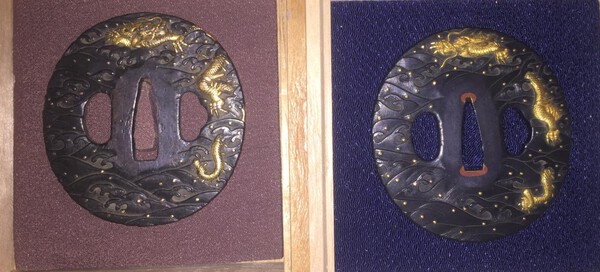-
Posts
445 -
Joined
-
Last visited
-
Days Won
7
Content Type
Profiles
Forums
Events
Store
Downloads
Gallery
Everything posted by Gordon Sanders
-
Thanks for the advice. Noted!
-
Hi guys. I have a kozuka and found a thematically matched wari-kogai. Only the WK is copper and not shakudo. Is it possible to match the Patina of the Kozaka?
-

Nthk Vs. Nbthk Papers
Gordon Sanders replied to Heringsdorf's topic in General Nihonto Related Discussion
Great post Darcy -
I was thinking the same thing Curran, as just a neophyte observer. It seemed that something large is missing
-

Nmb 2015 Lucky Prize Draw
Gordon Sanders replied to Brian's topic in General Nihonto Related Discussion
Awesome!!!!!! I love woodblock prints!j Thanks Grev and Brian Karma wins again!!!! -
Bump :-) Now that my sword is back from shinsa I would love to finish out the koshirae. Any Omori or Hidemoto school fk with clouds/waves/dragons?
-
I did forget to mention that the katana that just received the TH also has a Fujishiro Kanteisho (if that means much)
-
Hi guys, I just received word that my Kinmichi katana received Tokubetsu Hozon My Kinmichi wakizashi has both Tokubetsu Hozon and Yushu What is the value of getting a sayagaki created for each, and does it matter who does it? Thanks for your valuable opinions?
-

Help With Signature, Kinmichi ?
Gordon Sanders replied to Michael 67's topic in Translation Assistance
can we see better pictures of the blade? -

Kunishige (Hawley KUN 1048)
Gordon Sanders replied to Veli's topic in General Nihonto Related Discussion
I bought the museum book when I was home for christmas. I will see if there is a picture of it within -
Hi talented and distinguished hoarders Looking for F/K from either Hidemoto or Ormori school for a Daisho. I have a set of both and hoping to match one of them. Thanks for playing!!!
-

Found Old Sword In Friends Attic. Any Help On This?
Gordon Sanders replied to Hatrance's topic in Translation Assistance
More: RK2) Rai Kinmichi, 2nd generation, 1620, Yamashiro, wazamono, * Izumi (no) Kami Rai Kinmichi 和泉守来金道, * Fujiwara Rai Kinmichi 藤原来金道, * Daihoshi Hokyo Rai Kinmichi 大法師法橋来金道, * Daihoshi Hokyo Rai Eisen 大法師法橋来栄泉. On 5/6/1616, he received the title of "Izumi (no) Kami". Used kiku mon and eda kiku mon which is a kiku flower with branches, together with his mei on nakago. Produced gunome hamon. Iga-no-kami Kanemichi and Tsuda Sukehiro Kinmichi (金道), 3rd gen., Jōkyō (貞享, 1684-1688), Yamashiro 1 2 3 法 法 法 法 Nori, Hō 1 2 3 来 来 来 来 Rai, Kuru, Kura, Yuki (unsimplified 來 8 str. The Seki Daido school was founded by Kanemichi from Seki in Mino province. He was the grandson of the 9th generation descendant from Kaneuji 1st (Shizu-Saburo), one of Masamune's ten pupils and the founder of Mino-den. Kanemichi combined the style of his grandfather (the 9th generation Kaneuji) with his own techniques, thereby establishing the Mishina tradition. Kanemichi worked as early as the Tenmon era (1532). One daito by him is dated Tenmon 16 (1547), whilst another has the date of Eiroku 5 (1562). These are his earliest works. His work represents the transition years in the Keicho era where Koto gave way to Shinto. Kanemichi's swords were famed for their quality and extreme sharpness and his early work is usually signed with a two character signature. In Eiroku 12 (1569) this fame led to him being asked to make a tachi for the Emperor Ogimachi. On successfully completeing this he was rewarded by being authorised to use the O kanji from the emperor's name in his signature. This kanji is also pronounced as dai. Initially Kanemichi used it to make his signature read O-Kanemichi; there are many examples of this signature. Later, after being awarded Mutsu no kami, he dropped the character Kane from his mei, so that his mei read Omichi or Daido. There is an example dated Tensho 18 (1590) signed Mino Seki ju Daido. It is therefore likely that he and his sons moved to Kyoto after 1590.The name Daido was subsequently used, with various titles, by the several generations of students that followed. The shodai Daido (DAI 61) became the personal swordsmith of Oda Nobunaga. His four sons - Iga no Kami Kanemichi (Jo-saku), Rai Kinmichi (Jo-saku), Tanba no Kami Yoshimichi (Jo-saku), and Etchu no Kami Masatoshi (Jo-jo saku) - also made swords for Nobunaga. The work of these smiths have sharpness ratings of at least wazamono. His sons, and Omi no kami Hisamich (a student of Iga kami Kinmichi) were the Kyoto Gokaji, or the Five Swordsmiths of Kyoto. It seem that political considerations played some part in this elevation; the Mishina school was probably favoured by the new Tokugawa shogunate, whilst others may have been seen as supporters of the defeated Toyotomi forces. The Kyoto Gokaji were however extremely talented. Daido also trained many great smiths. https://www.dropbox.com/s/pgdjjokepeqlubp/Screenshot%202015-12-16%2013.36.25.png?dl=0 https://www.dropbox.com/s/c97yk1g0zvn0x4a/Screenshot%202015-12-16%2013.36.53.png?dl=0 https://www.dropbox.com/s/oxdjcb51w30ysja/Screenshot%202015-12-16%2013.37.06.png?dl=0 https://www.dropbox.com/s/7qql1v96yiwy9jc/Screenshot%202015-12-16%2013.37.26.png?dl=0 -

Found Old Sword In Friends Attic. Any Help On This?
Gordon Sanders replied to Hatrance's topic in Translation Assistance
Here is some more info on Kinmichi line Kanemichi is the recognised founder of the Mishina School. This school had its roots in Sue-Seki School of the late Koto period. Mishina Kanemichi was working as early as the Tenmon Era (1532). There is a daito with the date of Tenmon 16 (1547) which is Juyo Token. There is also another Juyo daito with the date of Eiroku 5 (1562). These are his earliest dated works. Shodai Daido was a smith working in the Mino tradition, and achieved the title of Mutsu no Kami in 1574. His work period dates to the transition years in the Keicho era where Koto gave way to Shinto. His history states that he was the personal swordsmith to Oda Nobunaga who employed smiths of the Mino tradition (the rise of his armies contributed to the spread of the Mino style throughout Japan, and its large contribution to what would become the Shinto style). He reportedly moved to Kyoto with his sons Iga no Kami Kanemichi (Jo-saku), Rai Kinmichi (Jo-saku), Tanba no Kami Yoshimichi (Jo-saku), and Etchu no Kami Masatoshi (Jo-jo saku) making swords for Nobunaga. They would become the Kyoto Gokaji, or the Five Swordsmiths of Kyoto. All of them have sharpness ratings of at least wazamono, so they made blades well in keeping of the warrior tradition of Mino, and from the success and fame of his sons it would seem that Daido was a very good teacher. Because he was authorised to use the “Dai” kanji, he dropped the character “Kane”from his signature thus making his name read Omichi or Daido. There is an example dated Tensho 18 (1590) that is signed Mino Seki Ju Daido. Because of this, it is thought that after that date he moved to Kyoto. Thus we see that his signature transformed along the following lines: - KANEMICHI SAKU - NOSHU SEKI JU KANEMICHI SAKU - OKANEMICHI - MUTSU NO KAMI KANEMICHI - DAIDO - MUTSU NO KAMI DAIDO - MINO SEKI JU DAIDO SAKU Rated as a Jo-saku smith, he trained many famous swordsmiths, many of which were his own sons. When you read the names of his sons, you will realise what a great smith Daido really was; * 1st son: Iga No Kami Kinmichi * 2nd son: Izumi No Kami Rai Kinmichi * 3rd son: Tamba No Kami Yoshimichi * 4th son: Etchu No Kami Masatoshi As you can see from the list, the very core of the Shinto Mishina School came from Daido. By seeing Daido’s past achievements, one can see how he was a “pioneer” in the early days of the Shinto period. Daidō (大道), 1st gen., Tenshō (天正, 1573-1592), Mino – „Kanemichi“ (兼道), „Ō-Kanemichi“ (大兼道), „Minamoto Mutsu no Kami Daidō saku“ (源陸奥守大道作), „Mutsu no Kami Daidō saku“ (陸奥守大道作), Muroya-school (室屋), according to transmission the grandson of Daichi (大知), it is said that he first signed with „Kanemichi“ (兼道) and that he worked in Seki, in the twelfth year of Eiroku (永禄, 1569) he forged a blade for emperor Ōgimachi (正親町, 1517-1593) whereupon he received the character „Dai/Ō“ (大) and the honorary title „Mutsu no Kami“ from the latter, calling himself henceforth „Ō-Kanemichi“ (大兼道, lit. „the Great Kanemichi“), „Ō- Kanemichi“ eventually became „Daidō“ („dō“ is the Sino-Japanese reading of the character „michi“), and so also the theory exists that Daidō was the same smith as Mishina Kanemichi (三品兼道) but this subject is not yet settled definitely, because of the similarities in workmanship of the two smiths it is also assumed that they were maybe brothers or father and son, „hybrid signatures“ of the kind „Ō-Kanemichi“ are found between the twelfth year of Eiroku (1569) and the first year of Tenshō (1573), he went later to Gifu (岐阜), Daidō was one of the few outstanding masters of the Sue-Seki school, he showed quite a wide variety of interpretations, for example he also worked in the Bizen and the Yamato tradition, former works have a ko-itame mixed with mokume in combination with a chōji-midare with midareutsuri, the latter show a regular masame with a suguha and remind of the Hoshō school (保昌), works in Mino tradition show a gunomemidare with compact nioiguchi mixed with tobiyaki, a Kenbō-midare, or also a large dimensioned and more nie-loaden gunome-midare which reminds of the Shizu school (志津) Source: Index of Japanese Swordsmiths by Marcus Sesko. -

Found Old Sword In Friends Attic. Any Help On This?
Gordon Sanders replied to Hatrance's topic in Translation Assistance
I believe This is the same smith when he was signing at a different period in his life There are smarter people here than I though. -

Found Old Sword In Friends Attic. Any Help On This?
Gordon Sanders replied to Hatrance's topic in Translation Assistance
Can we get a full picture also? What is the length? -
That is beautiful. Want!!
-
Thanks Stephen!!! Was pricey. But I got I good deal on the "dirty one" :-)
-
Hi guys and experts. I would live to be able to "clean up" the dirtier tsuba to match the cleaner one What would I do to make them match a little better in a nonDestuctive and preservation positive manner? Thanks or your knowledge , time, and humor
-
"impresssssssive". :-)
-
Beautiful pieces. I love the clouds. It has much depth
-
Grey.. You are in Duluth? Live that city and the bridge. And so many pedestrian bridges. Last was up there for the Inline Marathon from twin harbors to Duluth on I 35 :-). Hope you at keeping warm!!
-
I read somewhere that the best way to forge a signature is to turn the signature upside down and then copy Seemed to work pretty well for doctors notes at college way back when :-)






